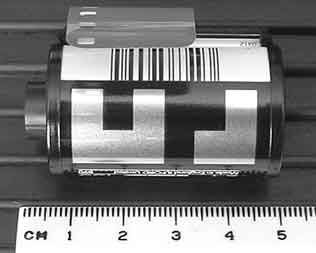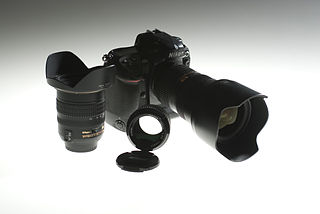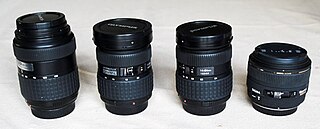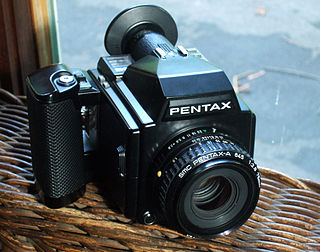
This article needs additional citations for verification .(February 2013) (Learn how and when to remove this template message) |
The Pentax PC35AF is a family of 35mm film point-and-shoot cameras by Pentax.

This article needs additional citations for verification .(February 2013) (Learn how and when to remove this template message) |
The Pentax PC35AF is a family of 35mm film point-and-shoot cameras by Pentax.
The camera features a self timer, flash (GN 11), automatic exposure with manual compensation of ± 1.5 EV and infrared autofocus system (minimum focusing distance 0.7 metres (2.3 ft)). The camera is powered by 2 AAA-size batteries. A winder is offered as an optional accessory.
The PC35AF-M offers an automatic film speed setting by means of the DX code (ISO 25 to 1600), with a manual setting (ISO 100, 200, 400, 1000) provided for when using film in a cartridge that lacks the DX code, and built-in winder. The camera is powered by 2 AA-size batteries.
The PC35AF-M DATE is equipped with a data-recording back that allows imprinting on the photograph of either the date (using the ymd format) or the time (using the HH mm format, ie. 24-hour clock, no seconds). The back is separately powered by two LR44 or SR44 button batteries.

DX encoding is an ANSI and I3A standard, originally introduced by Kodak in March 1983, for marking 135 and APS photographic film and film cartridges. It consists of several parts, a latent image DX film edge barcode on the film below the sprocket holes, a code on the cartridge used by automatic cameras, and a barcode on the cartridge read by photo-finishing machines.

The Nikon D2X is a 12.4-megapixel professional digital single-lens reflex camera (DSLR) that Nikon Corporation announced on September 16, 2004. The D2X was the high-resolution flagship in Nikon's DSLR line until June 2006 when it was supplanted by the D2Xs and, in time, the Nikon D3 range, Nikon D4 range and Nikon D5 — the latter three using a FX full-format sensor.

The Nikon F6 is a 35 mm film single-lens reflex camera body that became commercially available during 2004, and is the sixth top-of-the-line professional film camera in Nikon's line since the introduction of the Nikon F in 1959. The Nikon F6 is designed by Nikon and was manufactured at their Sendai Plant.

The Pentax Auto 110 and Pentax Auto 110 Super are single-lens reflex cameras made by Asahi Pentax that use Kodak's 110 film cartridge. The Auto 110 was introduced with three interchangeable lenses in 1978. Three more lenses were introduced in 1981, and then the Super model was released in 1982. The camera system was sold until 1985. The complete system is sometimes known as the Pentax System 10, apparently for its official Pentax name, although most Pentax advertising only uses the camera name or Pentax-110. This model represented the only complete ultraminiature SLR system manufactured for the 110 film format, although several fixed-lens 110 SLRs were sold. The camera system also claims to be the smallest interchangeable-lens SLR system ever created.

A digital single-lens reflex camera is a digital camera that combines the optics and the mechanisms of a single-lens reflex camera with a digital imaging sensor.

The Pentax K1000 is an interchangeable lens, 35 mm film, single-lens reflex (SLR) camera, manufactured by Asahi Optical Co., Ltd. from 1976 to 1997, originally in Japan. The K1000's extraordinary longevity makes it a historically significant camera. The K1000's inexpensive simplicity was a great virtue and earned it an unrivaled popularity as a basic but sturdy workhorse. The Pentax K1000 eventually sold over three million units.

The Nikon FG is an interchangeable lens, 35 mm film, single-lens reflex (SLR) camera. It was manufactured by Nippon Kogaku K. K. in Japan from 1982 to 1986.

The Nikon F-mount is a type of interchangeable lens mount developed by Nikon for its 35mm format single-lens reflex cameras. The F-mount was first introduced on the Nikon F camera in 1958, and features a three-lug bayonet mount with a 44 mm throat and a flange to focal plane distance of 46.5 mm. The company continues, with the 2020 D6 model, to use variations of the same lens mount specification for its film and digital SLR cameras.

Nikkormat was a brand of cameras produced by the Japanese optics company Nippon Kogaku K. K., as a consumer version of the professional Nikon brand. Nikkormat cameras, produced from 1965 until 1978, were simpler and more affordable than Nikon-branded cameras, but accepted the same lenses as the Nikon F series cameras.

The Pentax LX is a 35 mm single-lens reflex camera produced by Pentax in Japan. It was introduced in 1980 and produced until 2001. The LX uses the K mount which is the Pentax proprietary bayonet lens mount. It has manual and aperture priority automatic exposure modes. It is the top-of-the-line "professional" or "system" camera in the Pentax manual focus range, and has a large range of accessories. Compared with contemporary professional camera bodies from rival manufacturers, like the Canon New F-1 or Nikon F3, the LX body is smaller and lighter, weighing in at 570 grams with standard FA-1 finder.

Tilt–shift photography is the use of camera movements that change the orientation or position of the lens with respect to the film or image sensor on cameras.

The Minolta A-mount camera system was a line of photographic equipment from Minolta introduced in 1985 with the world's first integrated autofocus system in the camera body with interchangeable lenses. The system used a lens mount called A-mount, with a flange focal distance 44.50 mm, one millimeter longer, 43.5 mm, than the previous SR mount from 1958. The new mount was wider, 49.7 mm vs 44.97 mm, than the older SR-mount and had a longer flange focal distance making old manual lenses incompatible with the new system. The mount is now used by Sony, who bought the SLR camera division from Konica Minolta, Konica and Minolta having merged a few years before.

The Pentax ME F was an amateur level, interchangeable lens, 35 mm film, single-lens reflex (SLR) camera. It was manufactured by Asahi Optical Co., Ltd. of Japan from November 1981 to 1984. The ME F was a heavily modified version of the Pentax ME-Super, and a member of the Pentax M-series family of SLRs. It was the first mass-produced SLR camera to with an autofocus system.

This article is about photographic lenses for single-lens reflex film cameras (SLRs) and digital single-lens reflex cameras (DSLRs). Emphasis is on modern lenses for 35 mm film SLRs and for DSLRs with sensor sizes less than or equal to 35 mm ("full-frame").

The Minolta 9000 AF is a professional Single-lens reflex autofocus camera, introduced by Minolta in August 1985. It was both Minolta's and the world's first professional autofocus SLR. It was called Minolta Maxxum 9000 in the US and Minolta α-9000 in Japan.

The Pentax ME Super is a highly successful 35 mm single-lens reflex camera produced by Pentax of Japan between 1979 and 1984.

The Pentax Super-A, also sold in some markets as the Pentax Super Program was a 35 mm single-lens reflex camera produced by Pentax of Japan in the 1980s.

The Nikon D700 is a professional-grade full-frame digital single-lens reflex camera introduced by the Nikon Corporation in July 2008 and manufactured in Japan. It uses the same 12.1-megapixel "FX" CMOS image sensor as the Nikon D3, and is Nikon's second full-frame digital SLR camera.
This article discusses the cameras – mainly 35 mm SLRs – manufactured by Pentax Ricoh Imaging Corp. and its predecessors, Pentax Corporation and Asahi Optical Co., Ltd..

The Pentax 645 is a medium format single-lens reflex system camera manufactured by Pentax. It was introduced in 1984, along with a complementary line of lenses. It captures images nominally 6 cm × 4.5 cm on 120, 220, and 70 mm film, though the actual size of the images is 56 mm × 41.5 mm.